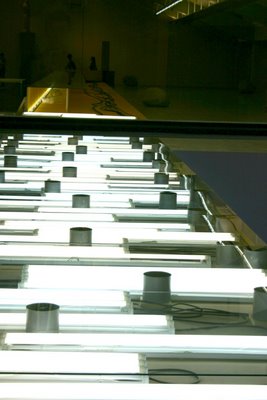A rose is a rose is a rose. Only each time it appears in a different light, in different hands, in different eyes, the name of the rose changes. If the above statement was as obvious as we would like it to be, if it encompassed all possible interpretations (of the world, of art), the world would be boring. Relativity only goes that far. Fortunately, things have a tendency to take shape. To taste, to appeal, to be
somethings. And I wonder if this is not exactly why a lot of contemporary art works so well for me: this tendency to be defined - and
not the opposite tendency to be all-relative or blurred!- is what gives it the tension, the controversy, the attraction and power.
A slide, in art, can hardly be a slide, can it?

We feel its tendency to be a slide, but it's this very change in definition, this provocation of designing it as something-else, something-more, some sort of hidden being, that brings about the blush of art experience.
There are several reasons why this slide can't just be a slide. 1) It is set at the Tate Gallery Turbine Hall; 2) It is considered a sculpture by its author; 3) It is considered a sculpture by the art milieu; 4) I feel like seeing it as something else (a sculpture, a performance, a social experiment, an undefined set).
Each of these reasons has an entire theory attached to it. Points 1) and 3) are closely related, they belong to the "institutional definition of art". Points 2) and 4) are both part of the "subjective definition of art", with some important differences.
But why bother defining? What does it matter? Can't we just enjoy the ride?

We can. Yet, we don't need to. And since art is to be an enriching experience (even if not always and not necessarily a pleasant one), why limit ourselves? Thus, the art amateur will know (what a scary word!) what he is dealing with. He will take pleasure in discovering all the undiscovered worlds that a quasi-ready-made (post-ready-made?) gives us. He will be extatic about the many directions, readings, he will talk about verticality, and danger, exhilaration, and pleasure... It has to do with enthusiasm and letting go, with laughter as an aesthetic experience, be it of the one laughing or of the one watching others laugh. The problem is, the deeper we go into the theory, the more concepts we use to describe the slide, the further we seem to get from the first purpose of the slide - to make us slide. Sure, we can consider it a wonderful performative installation, we can stay contemplative and look at how grandiose and imposing it seems. But all this would be nothing if there wasn't the sliding.
It seems only logical that the installation be presented at the
Turbine Hall. This is another turbine, a machine that we fuel. By forcing ourselves to forget the conceptual grid, with its heavy chunks of grey cell mass, and diving in. Only then does it seem possible to believe in the
utopian vision of a world in which slides are a means of getting from one place to another, an alternative to stairs, lifts and escalators.
And only then does this whole affair appear as fun, appealing, and something that actually
works, rather than as a funny but futile game. (Unless, of course, we accept art as being futile anyhow.)
Is there a difference between this slide and any other slide in the world? Any substantial difference? Not to me. Which doesn't in the least take away the value of this particular work, as art and as slide. Because thanks to this one, I will cherish watching slides, and sliding, even more. It brings a new starting perspective, like a paradigm that allows to see things with a previously unfelt freshness. I could hardly expect more from art.
There is a lot of time to visit the installation: Carsten Höller's Test Site, as the work is called, will stay at the London museum until April 9, 2007. More about the work: good article, excellent interview with the artist, medium article with a flash/podcast presentation, medium article but with the only note of criticism, original Tate site. Finally, the source of the photos.PS.: A friend pointed out that to go on the large slides one needs a free ticket. Now
that's a way of making you feel you're sliding art.















